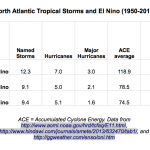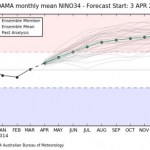El Nino
I have a little "science by spreadsheet" project for you, concerning the relationship between El Niño and Atlantic hurricanes.
The chance of an El Niño event happening this year seems to go up every few days, with most, perhaps all, climate models suggesting that El Niño will form this Summer or Fall. Climate experts tell us that there are typically fewer hurricanes in the Atlantic during El Niño years. So, I was interested to see how many fewer. Also, there appears to be a different kind of El Niño that happens sometimes, perhaps more often these days as an effect of global warming,…
... and by that I mean the El Niño phase of the El Niño Souther Oscillation climate pattern.
We have been in an ENSO neutral phase for a while. Climate scientists have a hard time predicting El Niño, which arrives in Summer, Fall, or Winter, this early in the year, but nonetheless most prediction sources, and most models, now tell us that we are likely to have one staring, really, any time, but most likely Summer or Fall. Here's a graph of several models. The bottom colored area is Le Niña, who we assume was Jesus Christ's sister, and the top colored area is El Ninño, with the middle part…
So, the bad news is that it is looking increasingly likely that the world will experience a very strong El Nino event this 2014-2015 winter (winter in the N. hemisphere, summer down under). There is even talk of a super-El Nino, one to rival 1998's phenomenal event. Lots of good information on that here at P3. Some forecasters are now putting the odds at 70%.
Model ensemble predictions showing a coming El Nino
The repercussions for global and regional weather are very large, there will be winners and losers, though as with climate change impacts in general, the wins are…
The 538 comment system appears to not be working, probably because of my current highly suspicious location, so I figured I'd put my comment here (since I spent a whole minute writing it):
"Long-range forecast models have come to a consensus recently that a minor to moderate El Niño pattern may develop six to nine months from now.
That just isn't true. Forecasts suggest a 50-50 chance of El Nino, but this is hard to predict. There is no consensus that an El Nino will develop among forecasters who are always super cautious about this prediction and there is only a 50-50 chance.
Also, I see…
tags: researchblogging.org, global warming, climate variation, climate change, penguins, El Nino, marine zoning, P. Dee Boersma
Adélie penguins, Pygoscelis adeliae, and chicks.
(a) Adélie penguin chicks may get covered in snow during storms, but beneath the snow their down is warm and dry. (b) When rain falls, downy Adélie chicks can get wet and, when soaked, can become hypothermic and die.
Images: P. Dee Boersma.
According to an article that was just published in the journal BioScience, penguin populations are declining sharply due to the combined effects of overfishing and pollution…
I have tried to make it quite clear a few times that regardless of no new record, there is no evidence that the underlying rising trend in global surface temperatures has reversed or stopped. But absent a short term rising trend the inattentive public is very vulnerable to disengenouous denialists claiming warming is over (did they ever admit it was happening??). So I am afraid that that talking point will not go away until 1998's record status does so as well.
So when will that happen? I'm not talking about statistically insignificant 0.05oC win by a nose in one record but not another, I…
Just a quick update on my recent post noting Roger Pielke's lack of integrity:
Roger makes a note of my post and John Fleck's and adds this underhanded toss-off line: Hansen's forecast "did not survive the peer review process" and so did not "appear in PNAS". Of course, the alledged "prediction" of a super El Nino ("there is a good chance") from the draft was not submitted to PNAS for peer review. Roger is refering to Hansen's passing the draft to a few friends and colleagues, inadvertently distributing it more broadly (oops, Roger's not a friend!).
There is a must read exchage at John…
I have made it pretty clear before that I am no fan of Roger Pielke Jr. Everytime I stick my nose in there the smell seems to get a little worse.
His latest effort at sabotaging productive discourse on climate science and policy is a really low blow, putting to rest any lingering hopes one might have had that he still had some integrity stashed away in there somewhere. Now I know these are strong words, but I have to confess this really gets my blood pressure up, it is just the slimiest of tactics. (I will happily retract this post and apologize if Roger makes ammends for his ethical…
tags: researchblogging.org, global warming, climate variation, climate change, penguins, El Nino, marine zoning, P. Dee Boersma
Adélie penguins, Pygoscelis adeliae, and chicks.
(a) Adélie penguin chicks may get covered in snow during storms, but beneath the snow their down is warm and dry. (b) When rain falls, downy Adélie chicks can get wet and, when soaked, can become hypothermic and die.
Images: P. Dee Boersma.
According to an article that was just published in the journal BioScience, penguin populations are declining sharply due to the combined effects of overfishing and pollution…
This is just one of dozens of responses to common climate change denial arguments, which can all be found at How to Talk to a Climate Sceptic.
Objection:
Global temperatures have been trending down since 1998. Global Warming is over.
Answer:
At the time, 1998 was a record high year in both the CRU and the NASA GISS analysis. In fact, it was not just a record year, it blew away the previous record by .2oC. (That previous record went all the way back to 1997, by the way!) According to NASA, it was elevated far above the trend line because 1998 was the year of the strongest El Nino of…

